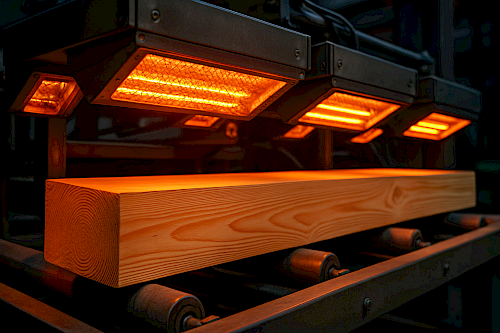
5 Mistakes Wood Manufacturers Make with Coating Curing (And How to Avoid Them)
Efficient and consistent coating curing is critical in modern wood manufacturing. Yet, many manufacturers still struggle with slow production, uneven finishes, and high energy costs. Mistakes in wood coating curing can lead to defects, bottlenecks, and wasted resources.
At Victory Lighting, we specialise in advanced UV and IR systems for wood processing, helping manufacturers speed up production while ensuring flawless finishes. In this article, we’ll explore the five most common wood coating curing mistakes and show you how to avoid them using smart, energy-efficient technologies.
1. Relying on Traditional Hot Air Drying
Many manufacturers still use natural or hot air drying for wood coatings. While familiar, these methods are slow, inconsistent, and energy-intensive. Uneven heat distribution often leads to poor surface quality and production delays.
How to avoid it: Upgrade to infrared (IR) or UV curing systems. IR delivers uniform heat for fast, efficient drying of primers, adhesives, and bulk coatings. UV systems cure lacquers and finishes in seconds, providing flawless, durable surfaces without the bottlenecks of hot air drying.
2. Ignoring the Right Curing Technology for Your Coating
Not all coatings respond the same way to drying or curing methods. Using the wrong technology can cause incomplete curing, cracking, or discoloration. For example, heat-sensitive finishes may warp under IR, while UV-incompatible coatings won’t achieve the desired hardness.
How to avoid it: Assess your coating type, line speed, and finish requirements before selecting a system. Victory’s engineers can recommend UV LED, medium pressure Gallium UV, or IR systems tailored to your production needs.
3. Overlooking Energy Efficiency in Wood Processing
Inefficient curing processes drive up costs and energy consumption. Hot air drying, in particular, can waste significant energy heating large volumes of air, even where only the surface needs curing.
How to avoid it: Use UV LED technology, which consumes up to 40% less energy than traditional methods. Pairing UV with IR can further optimise efficiency by reducing curing time while maintaining high-quality finishes. Energy savings also contribute to a more sustainable wood manufacturing process.
4. Failing to Maintain Consistent Production Speeds
Variations in curing speed can slow down production or create bottlenecks. If one part of the line is under- or over-cured, it can compromise the entire batch. Many manufacturers fail to calibrate their systems correctly, leading to inconsistent results.
How to avoid it: Calibrate your UV and IR systems for uniform curing across the production line. Victory’s precision-engineered systems provide repeatable, consistent curing at high line speeds, helping you increase throughput by up to 35%, as seen with UK kitchen manufacturers.
5. Neglecting Maintenance and Lamp Performance
Ignoring system upkeep is a common mistake that can lead to reduced lamp intensity, uneven curing, and unexpected downtime. Both UV and IR systems require regular maintenance to maintain optimal performance.
How to avoid it: Implement a routine maintenance schedule, monitor lamp performance, and replace worn components promptly. Victory offers direct engineer support to ensure your IR and UV systems operate at peak efficiency, reducing defects and production interruptions.
Avoiding these five mistakes can dramatically improve your wood coating quality, production speed, and energy efficiency. By upgrading to Victory’s advanced IR and UV curing systems, manufacturers can achieve flawless finishes, reduce energy consumption, and eliminate bottlenecks.
Take the next step: Speak to a Victory Lighting wood processing specialist to find the right solution for your production line.
Speak to our Wood Processing Specialists
Download our Wood Processing Solutions Brochure to explore UV and IR systems for your wood finishing needs.
